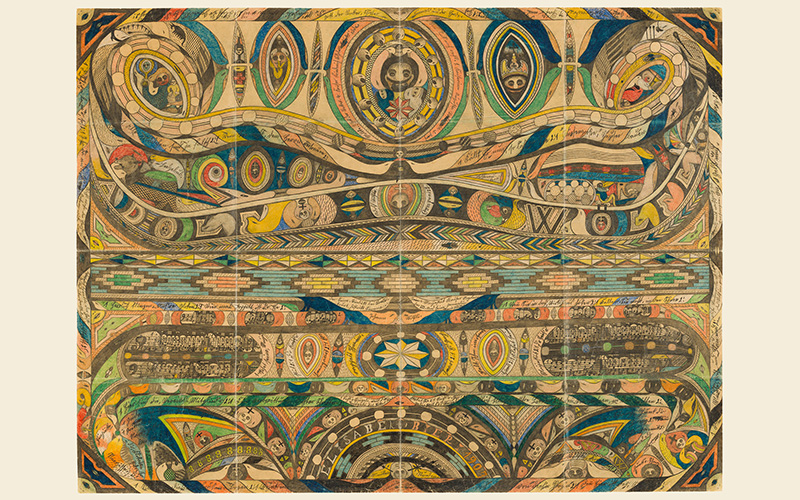
Adolf Wölfli (Swiss, 1864–1930), Elisabeth Bieri, 1907, graphite pencil and crayon on paper, 35 1/2 x 47 1/4 in. (90.1 x 120 cm), Collection of Richard Rosenthal
Verbal Description
Hello, my name is Jeff Burkart, and I am a gallery attendant at the museum. I will be reading the verbal description for Elisabeth Bieri by Adolf Wölfli in Creating Connections: Self-Taught Artists in the Rosenthal Collection.
The drawing, Elizabeth Bieri from 1907, is graphite pencil and crayon on paper. It was created by Adolf Wölfli, a Swiss artist who lived from 1864 to 1930. It is in the collection of Richard Rosenthal.
Adolf Wölfli’s large, detailed, landscape-oriented drawing, Elizabeth Bieri, measures 35 and one-half by 47 by one-quarter inches or 90.1 by 120 centimeters. In this work, the artist joined four pieces of paper, evident by four faint white lines that run vertically from top to bottom. The colors repeated throughout are peach, white, yellow, black, bright blue, light blue, green, and brown. This densely crowded drawing covers the paper with patterns from edge to edge. Starting at the top, we see four oval portrait medallions containing fantastical faces and creatures. Multi-layered ornamental frames surround each. In the frame around the central portrait are words written in script in German. A swirling curve extends the width of the drawing, framing the portrait medallions on each end; the curve is composed of white spheres and a striped border that also contains German writing. In the space between this band and the next curved band, the artist has added more small ovals containing heads, a creature that may be a dog, and more decorative designs. Moving down the sheet, the curved band just above the center of the drawing contains the artist’s name—Adolf Wölfli—written all in uppercase in elaborate decorative writing. The O’s in the artist’s name are oval medallions with heads surmounted by crosses, and stylized birds are interspersed among the letters.
Through the center of this crayon drawing is a band of straight geometric designs with diamond patterning in light blue, brown, white, green, peach, and yellow. Below the band are several other bands varying in thickness in which the artist has included musical notations, more portrait medallions, and geometric shapes. The final and bottom band comprises three semi-circular shapes. Around the center arc, the artist included the name and date “Elizabeth Bieri 1907.” A multi-colored patterned border containing German text frames this work.
Label Text
Hello, my name is Jeff Burkart, and I am a gallery attendant at the museum. I will be reading the label for Elisabeth Bieri by Adolf Wölfli in Creating Connections: Self-Taught Artists in the Rosenthal Collection.
The drawing, Elizabeth Bieri from 1907, is graphite pencil and crayon on paper. It was created by Adolf Wölfli, a Swiss artist who lived from 1864 to 1930. It is in the collection of Richard Rosenthal.
This tapestry-like drawing from 1907 was one of Adolf Wölfli’s first in color. Look for his name hidden amid the dense ornamental patterns and myriad heads, birds, and musical notations. Wölfli worked for the family of Elisabeth Bieri, whose name appears near the bottom, during his profoundly troubled boyhood.
At the Waldau psychiatric facility in Bern, Switzerland, where he was institutionalized for 35 years, Wölfli reportedly went through a pencil every two to three days and never used a straight edge. All total, his imaginative opus comprised 25,000 pages of fantasy autobiography interwoven with poetry, artwork, and musical compositions. Wölfli was among the first artists diagnosed with severe mental illness to be recognized and collected. In 1921, Walter Morgenthaler, a Waldau psychiatrist, published an influential book in which he notably described Wölfli’s creative output as art and identified him by name instead of a number. This book encouraged Jean Dubuffet and his colleagues to seek out individualists like Wölfli.
